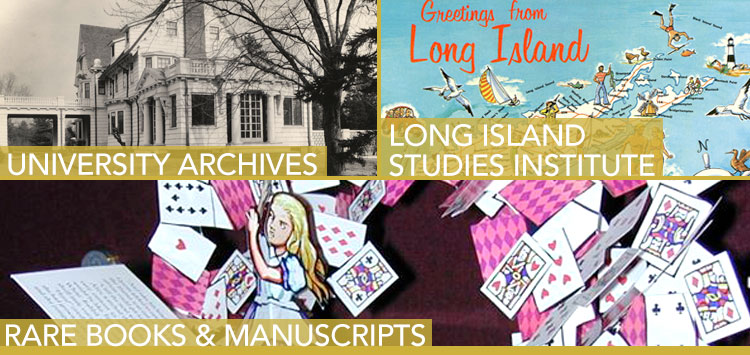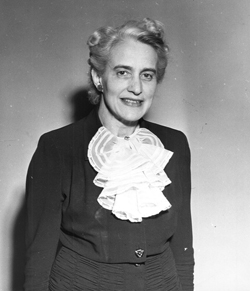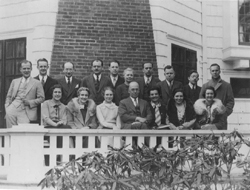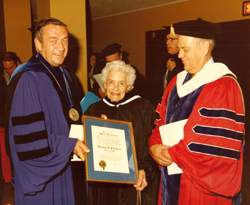Eleanor Blodgett
August 18, 1896 - September 21, 1990
Served as one of Hofstra’s First Faculty Members
The First Faculty
Ms. Blodgett with Former Hofstra Presidents
James Shuart and John Cranford Adams
Contact Information
Click to Play Audio from Oral History Interview
conducted on October 4, 1978
Transcript of Audio
The chairman of the English Department, Dr. Homer Watt, invited me to lunch. He asked me if I would like to go out to Hofstra to be a member of the English Department. This was to be a new college under the auspices of New York University; it was Nassau College Hofstra Memorial. And this was in 1935, in the spring. I hadn’t heard of anything of the kind and I didn’t know whether I wanted to leave New York University and he assured me that if this experiment failed I would be taken back and I should think about it. They wanted a woman. I went out to see Hofstra and was shown the campus of the Hofstra estate. It was a really a beautiful estate for a college center. The whole situation appealed to me very much and I thought that I would like to be a part of it. In the fall the charter class assembled and the recruiters of that class had really done an excellent job. That was in the depression years and of course a good many of the students had wondered whether they were going to be financially able to go to college if they had to go away from Long Island. And the men who had done the recruiting had succeeded in getting all the valedictorians and the salutatorians from the neighboring high schools-
Of course immediately wanted to establish various activities and it was announced that they would not play football, they were going to play rugby. That rugby was a game that would be well within the ability of a new institution where they hadn’t been playing before and they were persuaded that this would be an excellent substitute for football. And I think it was because they went out and played teams from some of the major universities and an English team came over here and played and our team showed up very well. There was no gym. All the activities, really, were confined to Hofstra Hall except for the playing field just behind the house.
The first faculty is pictured in this first Nexus and I think this is a beginning of a good history of Hofstra. It was understood, of course, at the beginning, that this was to be a two-year college, an experimental college, and that they would presumably go on to New York University when they finished two years. But the class determined from the beginning that it was going to be a four-year college. The original charter, I think, was for two years but it wasn’t very long and in fact I think it was January 1936, certainly no later than ’ 37, that they had that charter for four years. And it was explained to the students that the college would continue, that those who had come with the assurance that they would get a degree from NYU would receive a degree from NYU. We went to two commencements that year. We went up to NYU for the commencement of the entire university, and then we had another commencement here at Hofstra, out in front of Hofstra Hall and this was 1939.
Well I hoped to get the students interested in that before the war but it didn’t amount to very much. There were too many distractions and alumni hadn’t been out in the world long enough to be able to do much for the college or for any of the reasons why there should have been such an organization. But after the war I would give special credit to Dr. John Robert Janes of the class of ’39 for working very hard on the establishment of Alumni Association. I worked with him but he did a great deal and he got classes organized and we tried to keep them in touch with the college. Well, after Dr. Adams came as president, he brought in Mr. Francis Pray as a public relations man and Fran Pray asked if I could come into this office and work on alumni problems. I was very glad to do this and I guess I was relieved of a couple of classes in order to do it, and we started an alumni newsletter and we took every means to keep them informed about the college and bring them back. And one of the very interested workers in that was Bill Kaiser and it wasn’t very long before I could be relieved of my work there in the alumni office and he took over. And I felt that he did a wonderful job.
Well, I associated with Cullen Bryant Colton, who was a member of the English Department. But anyway, we had a number of Phi Beta Kappa members on the faculty and we were talking about it, this included Hans Gottlieb of the English Department, Milton Williams of the Philosophy Department, and Cullen and a number of others. And we felt that something should be done to prepare for an application for membership in Phi Beta Kappa. So, we asked Dr. Calkins if that would be right and said that because of the Sigma Psi people in the Science Department and the members of Phi Beta Kappa, we thought we would have a good nucleus. He said, yes, that was alright but he didn’t want the faculty membership to be confined to those people and he stipulated certain members who should be included. One of them was Gray Truitt, Economics, he was a good man. And so, we got together and we made a plan for it. Our first group was from the Class of 1940 and we had six members. Three men and three women; that just happened, that is, we didn’t make any distinction in our nominations. But we sent them their notices of election and we had dinner at which they were initiated and each one was introduced by his faculty member and they were duly honored. It was not on campus. The early dinners were at (Shadow Lawn). Through the years, I tried to keep in touch with the students who had been elected and every year we sent each one of them a special letter of invitation to the dinner and I wrote a personal note on it and asked for a response with some news and I made a report at the dinner. So that I felt that, in a way, held us together and it, of course became a very large organization.
Of course immediately wanted to establish various activities and it was announced that they would not play football, they were going to play rugby. That rugby was a game that would be well within the ability of a new institution where they hadn’t been playing before and they were persuaded that this would be an excellent substitute for football. And I think it was because they went out and played teams from some of the major universities and an English team came over here and played and our team showed up very well. There was no gym. All the activities, really, were confined to Hofstra Hall except for the playing field just behind the house.
The first faculty is pictured in this first Nexus and I think this is a beginning of a good history of Hofstra. It was understood, of course, at the beginning, that this was to be a two-year college, an experimental college, and that they would presumably go on to New York University when they finished two years. But the class determined from the beginning that it was going to be a four-year college. The original charter, I think, was for two years but it wasn’t very long and in fact I think it was January 1936, certainly no later than ’ 37, that they had that charter for four years. And it was explained to the students that the college would continue, that those who had come with the assurance that they would get a degree from NYU would receive a degree from NYU. We went to two commencements that year. We went up to NYU for the commencement of the entire university, and then we had another commencement here at Hofstra, out in front of Hofstra Hall and this was 1939.
Well I hoped to get the students interested in that before the war but it didn’t amount to very much. There were too many distractions and alumni hadn’t been out in the world long enough to be able to do much for the college or for any of the reasons why there should have been such an organization. But after the war I would give special credit to Dr. John Robert Janes of the class of ’39 for working very hard on the establishment of Alumni Association. I worked with him but he did a great deal and he got classes organized and we tried to keep them in touch with the college. Well, after Dr. Adams came as president, he brought in Mr. Francis Pray as a public relations man and Fran Pray asked if I could come into this office and work on alumni problems. I was very glad to do this and I guess I was relieved of a couple of classes in order to do it, and we started an alumni newsletter and we took every means to keep them informed about the college and bring them back. And one of the very interested workers in that was Bill Kaiser and it wasn’t very long before I could be relieved of my work there in the alumni office and he took over. And I felt that he did a wonderful job.
Well, I associated with Cullen Bryant Colton, who was a member of the English Department. But anyway, we had a number of Phi Beta Kappa members on the faculty and we were talking about it, this included Hans Gottlieb of the English Department, Milton Williams of the Philosophy Department, and Cullen and a number of others. And we felt that something should be done to prepare for an application for membership in Phi Beta Kappa. So, we asked Dr. Calkins if that would be right and said that because of the Sigma Psi people in the Science Department and the members of Phi Beta Kappa, we thought we would have a good nucleus. He said, yes, that was alright but he didn’t want the faculty membership to be confined to those people and he stipulated certain members who should be included. One of them was Gray Truitt, Economics, he was a good man. And so, we got together and we made a plan for it. Our first group was from the Class of 1940 and we had six members. Three men and three women; that just happened, that is, we didn’t make any distinction in our nominations. But we sent them their notices of election and we had dinner at which they were initiated and each one was introduced by his faculty member and they were duly honored. It was not on campus. The early dinners were at (Shadow Lawn). Through the years, I tried to keep in touch with the students who had been elected and every year we sent each one of them a special letter of invitation to the dinner and I wrote a personal note on it and asked for a response with some news and I made a report at the dinner. So that I felt that, in a way, held us together and it, of course became a very large organization.





